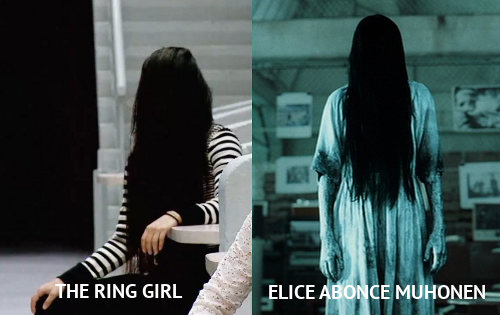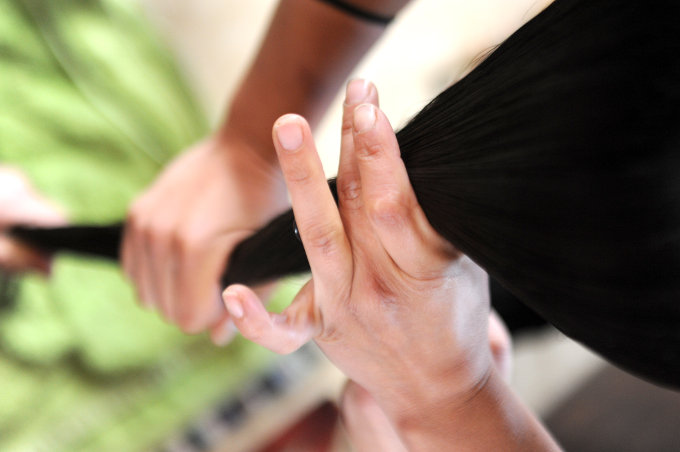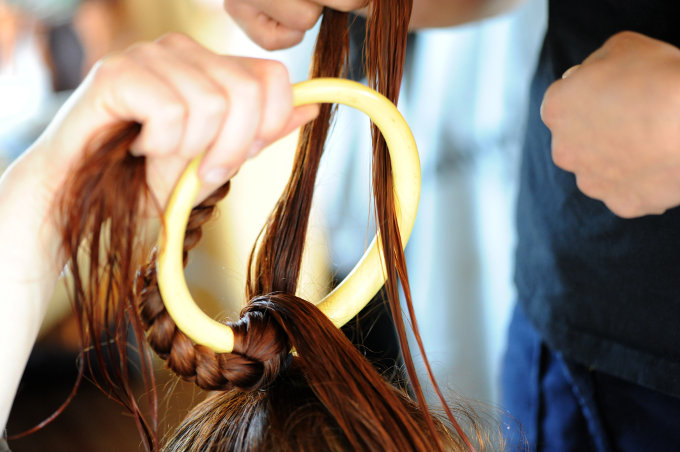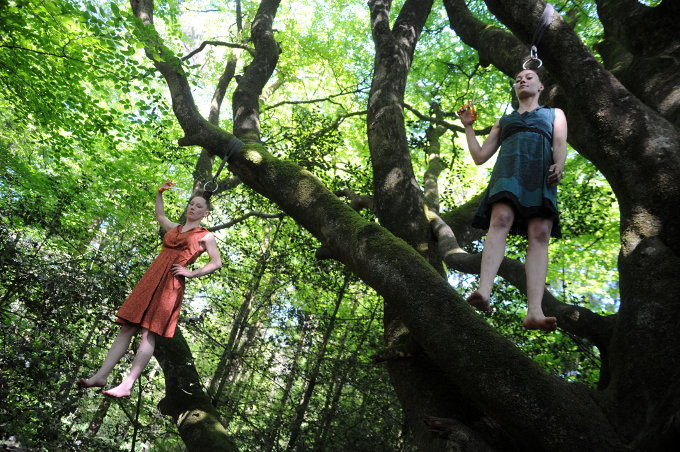Capilotractées
'I really remember the first time,' says Elice, long black hair pinned up (but loosely) after a rehearsal. 'Sometimes it cracks the spine, but you hear all these small things as well – these tiny noises – and it's like the sounds are coming from inside your head. When you hang it's... well, there are a lot of different things at the same time. First it changes the face – like there's a kind of face lift as the hair takes the weight.' She gestures upward with her hands (the face goes this way) as Sanja, long orange hair let down, takes over: 'First it takes your hair and then it takes your skull – so your skull is pulling on your face and then your eyes... It's not really a pleasant feeling, but you pass it – at first there's some pain and it's unpleasant, but then at some point you don't feel it anymore. You have to pass this kind of thing, and then with the adrenalin of the show you don't feel it in the same way. The first time you do it you're not sure if it's healthy or not, but we've been practicing it for three years now.'
For artists of the traditional circus, hair hanging is often learned at a young age and the method of preparing the hair – a lengthy process that involves complexly braiding it into a metal or wooden ring – is handed down within families as a guarded secret. For Sanja Kosonen and Elice Abonce Muhonen – neither of whom come from a traditional circus background, both of whom trained at the Centre National des Arts du Cirque in better charted disciplines – learning to hair hang was a two-year project of research, informed guesswork, trial and error, and bloody-minded endurance that culminated in the creation of their first show together, Capilotractées. They've now performed the piece 28 times in five countries, but when they set out to make it they had no idea what they would create, when it would be finished, or how exactly they would go about the work.
It all started in 2010 when Sanja, working as a wire artist with Les Colporteurs, was performing at a festival in Brittany organised by Galapiat Cirque, a lively six-strong collective of circus artists that Elice founded with five friends in 2006. The two already knew each other well. 'When we were in France both of us had the same lifestyle,' remembers Elice, 'living in caravans, moving around all the time. So we would see each other from time to time at festivals or when we had breaks in touring – it was this kind of friendship.' Still, they had never worked with each other, and when Elice suggested they make a show Sanja was enthusiastic but had her doubts, thinking that their two disciplines – tightwire and trapeze – wouldn't combine well.
Considering it, Sanja came up with another suggestion: they could learn to hair hang. Two decades earlier she'd seen a girl perform the skill in Sirkus Finlandia and the image had stuck with her – it was her oldest circus memory, something that was so real yet at the same time so impossible, so fantastic, so unbelievable.
46s // transcript
'I don't know why we decided that we should try it for ourselves,' says Sanja, smiling a little at the memory. 'We just got it into our heads that that was what we were going to do, and somehow Elice was crazy enough that she thought it was a good idea.'
At the start it was only an idea: they didn't know how to hair hang, didn't know anybody who could teach them, and back then neither Sanja nor Elice had worked on a show outside of a larger collective. 'We really started from nothing,' says Sanja. 'It was crazy because we went to some theatres and to people we know to ask them to help us with our project and then we had to tell them that we didn't know what it was or where it was going – that we didn't even know how to do the hair hanging. To ourselves we just said that we'd try the skill and see where it led us.'
With little to go on, they set out to collect information on hair hanging itself – any stories, any video, any contacts. Following a few leads, they managed to track down the artist Sanja had seen in Sirkus Finlandia and to speak to her on the phone – but how the hair was prepared she didn't remember. She'd been young at the time and it was her mother who had set it. She recalled only a few sensations and sounds: that the hair was wet, that it was tied very tightly, and that there was a loud noise, a kind of cracking sound, as the bindings were pulled tight.
Sanja also went to the library at CNAC to look through the books and archive films. Again, there wasn't much: 'You can find a few images, but there's really not much information about it. It's quite amazing that it's so rare but that it's something that's always existed in circus...'
Once they'd pieced together the information they'd gathered and worked out their own way to prepare the hair, all that was left was to train the skill itself – a process that lasted two years. At first, the goal was only to build endurance. 'We bought a pull-up bar and set it up in Sanja's apartment and started to hang from that,' says Elice, pulling up her knees and wrapping her arms around them to complete the image of herself scrunched up in the doorframe. 'It went forward slowly as we had to train our muscles little by little. We'd time ourselves: three times five seconds, then seven seconds, ten, fifteen, three times fifteen seconds, and so on.' At first the pain was almost unbearable. 'I think I could never have done it without Sanja,' says Elice. 'Because it was the two of us we boosted each other. You need to have a hard head to cope with the hanging; it's really not a nice feeling in the beginning.'
But the longer they did it the longer they could hang, and as they built up their endurance they had a series of residencies and rehearsal periods to work on movement material. In the air they experienced a feeling of both freedom and limitation. 'It depends if you can touch the floor or not,' says Sanja, 'but you can make some movements that are impossible normally – you have your feet and your hands free and it's quite amazing to have that feeling. It gives you a lot of possibilities for movement. At the same time you're quite limited when you can't move your head so much – you feel like a marionette.'
They also became familiar with the routine of preparing the hair, which takes at least an hour – thirty minutes for each of them. 'It's like a concentrated moment when we have to be really precise,' says Sanja, 'because if we miss it we can't do it. If it pulls from one point it can be painful or even dangerous, so it really has to be the perfect hairdo. If we miss it we have to redo it, so we take a lot of time and quite often close the doors and let no one come in. It's almost a kind of secret meditation.'
"It's like a concentrated moment when we have to be really precise, because if we miss it we can't do it."
At the same time as Sanja and Elice were training the hair hanging they were thinking as well about what sort of show they wanted to create. They talked a lot with Vimala Pons and Tsirihaka Harrivel, two of the members of the company Ivan Mosjoukine, and invited Tsirihaka to work with them as an outside eye. 'We were having a lot of conversations about what the contemporary circus is today, and about how you begin a circus creation,' says Sanja. 'Because there's no method in circus; in theatre you can take a text and you work from that, but in circus you have your vocabulary – I mean your physical vocabulary, the tricks you've learned – and from that you have to invent a method for how you'll work. Today circus can be anything and you can use any method you want. It's a strange and really interesting thing to make a circus show today.'
'Vimala and Tsirihaka were asking us a lot of questions like, What does the hair hanging actually do to you?' Says Elice. 'So we looked at ways to show the audience how it feels when we do this. We also asked ourselves how we could create a one-hour show from something that's traditionally just a five-minute number because we thought it deserved more than five minutes. Of course there are a lot of other things in Capilotractées, but all the material is more or less inspired by hanging and the hair.'
Before they began the show, both had actually been using their hair in other performances – Sanja by playing with her hair when walking the tightwire. 'It's something really everyday, a really intimate thing, and so people love the image of walking the wire and playing with the hair. It's simple, but it's something that relates the amazing thing of walking on a wire with something everybody knows from their own life.'

'And me,' says Elice, 'I have this little monster. A hair character. Like the girl in The Ring.' She mimes loose hair falling over her face. 'But it gives another way to transform yourself – or more like another way of showing yourself. Hair is just something really powerful, something that has so many stories and histories behind it. So the hair hanging spoke to me in another way – as a circus discipline, but also as an image that touches something important in people's lives.'
'I think that's also why there's a strong reaction when you say you're going to hang from your hair,' says Sanja, 'because the hair is something so intimate for women. It's something beautiful, so you should be careful with it. The more we got into hair as a theme the more we saw how important it is.'
As they developed material for the show they discovered images which were strong but which they judged too violent for the piece they wanted to create. In one scene Sanja stood on a tower of paper as Elice pulled the sheets out one by one, her hair taking her weight gradually until Elice kicked the tower away. It was powerful, but 'too much like watching someone being hanged'.
'The image of hair hanging can be really violent,' says Elice, 'so we decided that as it's so absurd to hang from your hair the show had to be funny in some way also. In the beginning we were also talking about how we wanted to make something that had a sort of Finnish sensibility – we wanted to express ourselves in small ways, and to just be what we are and not to play so much with character.'
1m 21s // transcript
Elice: 'I think it's something really Finnish, something we have in ourselves, to express yourself with small things also – and to be what we are. We don't play so much with characters or something. A little bit, but it's always something that comes from ourselves; we are not actors.'
Sanja: 'Circus is something honest – somebody who does a salto is really doing it, they're not "playing" doing a salto. So it's something about that also. I think the minimalism comes from there – to see what is the essence of the thing. What is the essence of the hair hanging? When you see these traditional numbers suddenly the girl flies up and she's turning around and it's going really fast and you can see her flying. So we were more like, OK, you can really first show what is happening in the body when it gets lifted. So with minimalism we get more in the details and the concrete things.'
In April 2013 they finished Capilotractées and began to tour the show around Europe. What actually happens during its 60 minutes they prefer not to say, enjoying the idea that the show, like the art itself, can keep some of its secrets.
What they will tell you is that people react differently – though often audibly – to the sight of the hair hanging itself. Broadly audiences divide into those who suffer in sympathy with the artists, thinking they must be masking a constant agony, and those who assume that for trained professionals like these perhaps it doesn't hurt at all. 'It's something that everyone can understand because if you have hair you know how it feels to yank it,' says Sanja, 'so you know the pain in a way. But at the same time nobody knows how it is to actually hang from their hair, so different people imagine different things. And still there are the ones who think that it's not real – even when we show everything, show we don't have any tricks. Some people want to touch our hair after the show: Is it real? And that's the funny thing about it – it's something so strange that even if people see it in front of their eyes they're not sure if it's true or not.'
Capilotractées is the first performance of Sanja Kosonen and Elice Abonce Muhonen. After training in gymnastics from a young age Sanja joined the youth circus school Turun Sirkus ry before undertaking pedagogic training at the Arts Academy of Turku University of Applied Sciences and further artistic training at CNAC. Touring with Les Colporteurs she performed in Le Fil sous la Neige, Tarina et Haute Pointure, and Sur la Route. Elice came from dance and theatre to train at Lahden Käsi in Finland and Cirkus Piloterna in Sweden. At CNAC she specialised in trapeze and, with five friends from the school, formed the company Galapiat Cirque, participating in the creation of the show Risque Zéro and working on Galapiat's annual festival Tant qu'il y aura des mouettes.
John Ellingsworth interviewed Sanja Kosonen and Elice Abonce Muhonen on 13 March 2014 in the quiet upstairs cafeteria of Le Channel in Calais during Libertés de Séjour, and again on 5 April 2014 in the noisy downstairs cafe of the Roundhouse during CircusFest. He saw the show at the Roundhouse on 1 April 2014. Mark Morreau shot the video in Brussels for Crying Out Loud, who produced Capilotractées in the UK.
This article uses Skrollr for fade-in/parallax effects, jPlayer for audio, and Scrollzip to trigger video. It was produced with the support of the Roundhouse within the frame of CircusFest, where John Ellingsworth was writer in residence.


